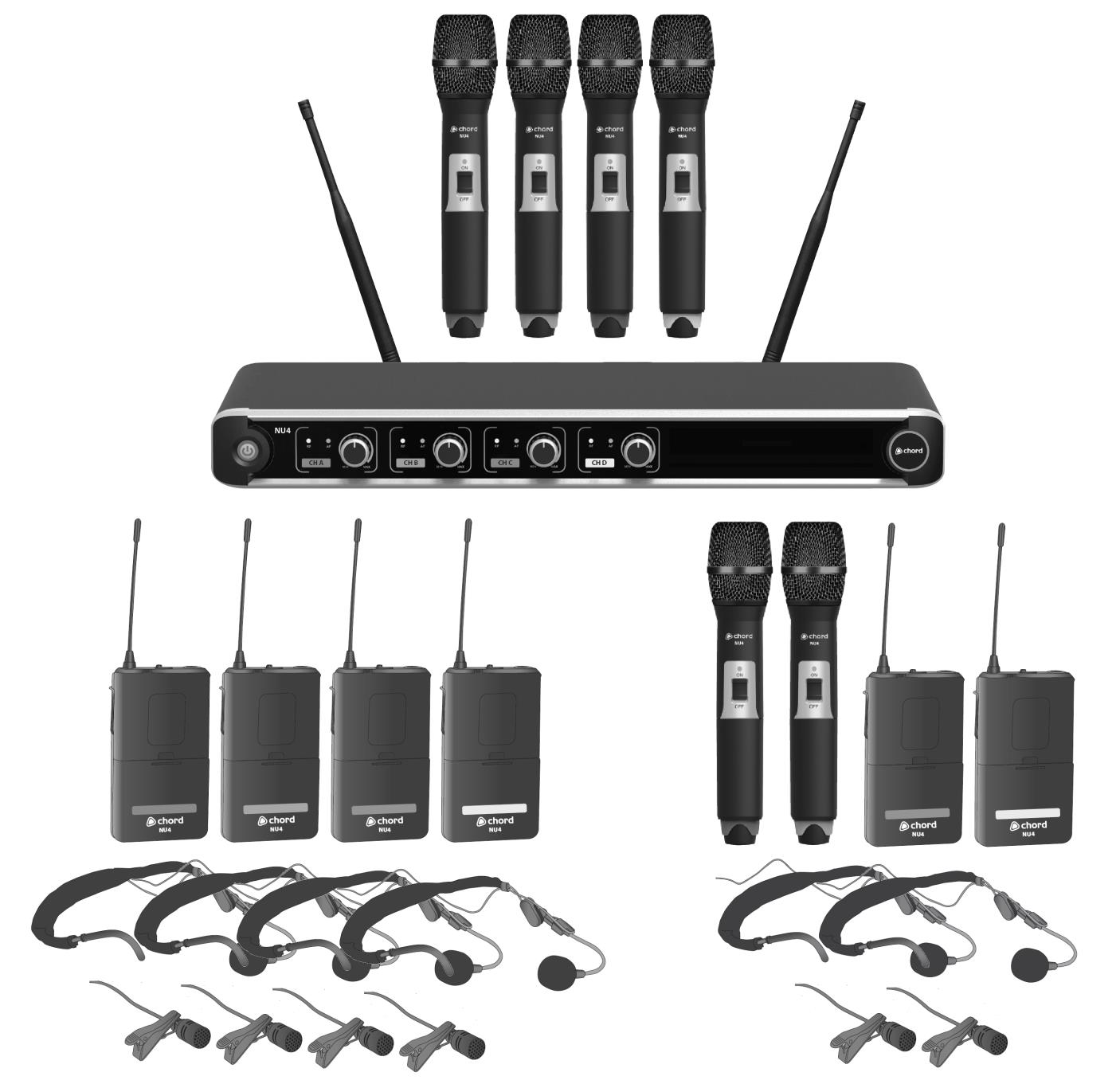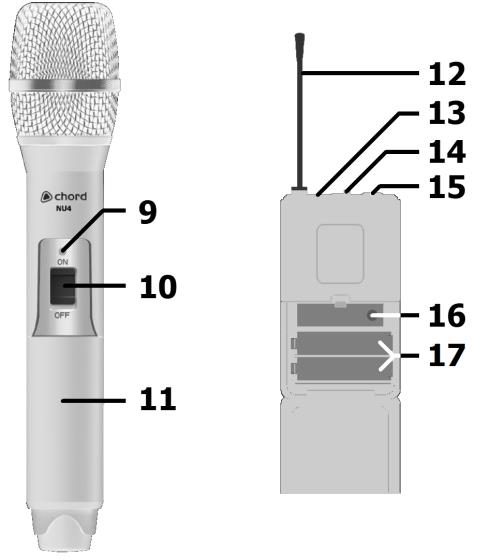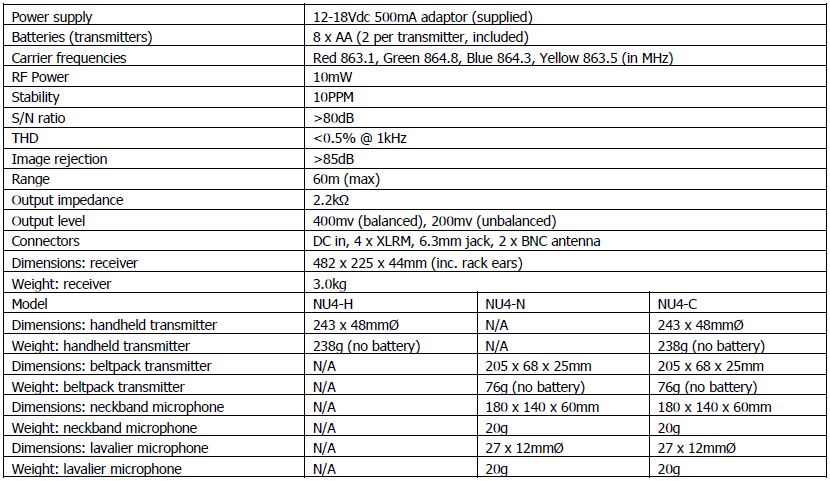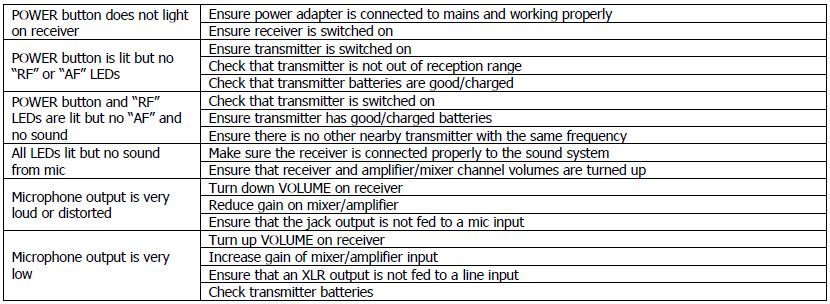NU4 Quad UHF Wireless System
Item ref: 171.843UK, 171.844UK, 171.845UKUser Manual

Caution: Please read this manual carefully before operatingDamage caused by misuse is not covered by the warranty
Introduction
Thank you for choosing the Chord NU4 wireless system. This professional wireless set provides 4 high quality microphones with UHF radio system for freedom of movement without compromising audio quality.
Please read this manual before using this equipment in order to avoid damage through incorrect operation and to get the best performance from your purchase.
Package Contents
- NU4 quad UHF wireless receiver
- 19” rack mounting ears
- 2 x UHF aerials
- 2 x BNC antenna cables (for front panel mounting)
- 4 handheld transmitters (NU4-H)
- 4 beltpack transmitters with 4 neckband and 4 lavalier microphones (NU4-N)
- 2 handheld and 2 beltpack transmitters with 2 neckband and 2 lavalier microphones (NU4-C)
- Mains power adapter
- 6.3mm mono jack lead
- 8 x 1.5V AA battery
If you find any accessory is missing or the product has arrived with any problems, contact your retailer.
These products contain no user-serviceable parts inside. Do not attempt to try to fix or modify these items yourself as this will invalidate the warranty. We recommend you keep the original package and proof of purchase for any possible replacement or returned demand.
Warning
To prevent the risk of fire or electric shock, do not expose any of the components to rain or moisture.
If liquids are spilled on any component, stop using immediately, allow unit to dry out and have checked by qualified personnel before further use.
Avoid impact or heavy vibration to any of the components, dropping the microphone can cause capsule failure. No user serviceable parts inside transmitter or receiver – refer servicing to qualified service personnel.
Safety
- Ensure that the correct power adaptor is used with adequate current rating (500mA minimum) and that the mains voltage is as stated on the adapter.
- Avoid ingress of water or particles into the transmitters or receiver
- Use alkaline or NiMH batteries in the transmitters and remove if unused for long periods.
- Observe the correct polarity when replacing batteries
Placement
- Keep all components out of direct sunlight and away from heat sources.
- Do not place heavy objects on top of the receiver or transmitters
- If rack-mounting, use rack ears provided and do not place heavy equipment above the receiver.
- Keep the transmitters and receiver away from damp or dusty environments.
Cleaning
- Use a soft cloth with a neutral detergent to clean the body of the handheld transmitter and receiver.
- Lightly damp sterile wipes may be used on the microphone grille for hygiene purposes
- To avoid damage, do not use solvents to clean the components
Receiver Front Panel

1. Power on/off button2. RF carrier LED indicators3. Individual channel volume controls4. AF signal LED indicators
Receiver Rear Panel

5. DC power input jack6. BNC antenna connectors7. 6.3mm jack mix output8. XLR individual channel balanced outputs
Transmitters

Handheld
9. On LED indicator10. On/off switch11. Battery compartment
Beltpack
12. Antenna13. On LED indicator14. On/off switch15. 3.5mm threaded jack socket16. Gain control17. Battery compartment
Note: If replacement transmitters are required, these must be genuine Chord NU4 transmitters, which transmit the correct pilot tone to sync with the receiver. Transmitters which have the same carrier frequency but not the correct pilot tone will not work with the NU4 receiver.
Setting Up
For handheld transmitters, insert the supplied AA batteries by carefully unscrewing the base to reveal the battery compartment inside the microphone body, connect the batteries (ensuring that + and – are the correct way around for each cell) and carefully screw the base back on.
For beltpack transmitters, squeeze and flip forward the front cover to reveal the battery compartment and insert AA batteries, observing correct polarity. Connect the 3.5mm jack connector from the neckband or lavalier microphone to the input on top of the beltpack transmitter and rotate to secure the thread.
Position the receiver within the best available line of sight to the transmitters.Connect both antennas to the BNC connectors on the rear panel or alternatively, if rack-mounted, attach to the front rack ears, using the BNC extension leads supplied.
A choice of mixed output of all 4 microphones on 6.3mm jack or individual balanced XLR outputs is available on the rear panel of the receiver. Connect jack or XLR (optional) leads to the relative output connector(s), turn down the volume of any equipment (mixer, amplifier etc.) that the signal will be fed into and then connect the jack or XLRs to the equipment.
Connect the DC jack of the supplied power adapter to the receiver and the plug-top to an available mains outlet, ensuring that it provides the correct voltage.
Operation
Turn down mic levels (3) on the receiver unit, then press and hold the power button (1) to power up.
Warning! – take care not to point microphones towards speakers – this can cause damaging feedback (loud whistle or howling noise) – try to aim microphones away from the speaker cabinets.
Move the switch on each handheld or beltpack transmitter in turn to the “ON” position.The RF LED indicator (2) should light to confirm that the carrier signal is being received.
Increase the volume control on the NU4 receiver and volume control(s) on the sound system until the sound from each microphone can be heard through the sound equipment.
The AF indicator (4) should flash with the audio that is being received.When the wireless system is not being used, it is good practice to slide the transmitter switch to the “OFF” position, which mutes and deactivates the radio signal and powers down the transmitter. Turn down the volume of the mixer or amp and then switch off the receiver.
Unplug signal leads from the receiver and mixer or amplifier when moving or packing away. If the system is not to be used for long periods of time, remove the batteries from the transmitters and unplug the power adapter from the receiver and the mains outlet. Folding away or removing the antennas can also help avoid damage when the system is not in use.
Specifications

Troubleshooting


Disposal: The “Crossed Wheelie Bin” symbol on the product means that the product is classed as Electrical or Electronic equipment and should not be disposed with other household or commercial waste at the end of its useful life.
The goods must be disposed of according to your local council guidelines.
Hereby, AVSL Group Ltd. declares that the radio equipment type 171.843UK, 171.844UK, and 171.845UK is in compliance with Directive 2014/53/EU
The full text of the EU declaration of conformity for 171.843UK is available at the following internet address: [pdf]
The full text of the EU declaration of conformity for 171.844UK is available at the following internet address: [pdf]
The full text of the EU declaration of conformity for 171.845UK is available at the following internet address: [pdf]
Errors and omissions excepted. Copyright© 2020. AVSL Group Ltd.Unit 2-4 Bridgewater Park, Taylor Rd. Manchester. M41 7JQ
chord NU4 Quad UHF Wireless System User Manual – chord NU4 Quad UHF Wireless System User Manual –
[xyz-ips snippet=”download-snippet”]


